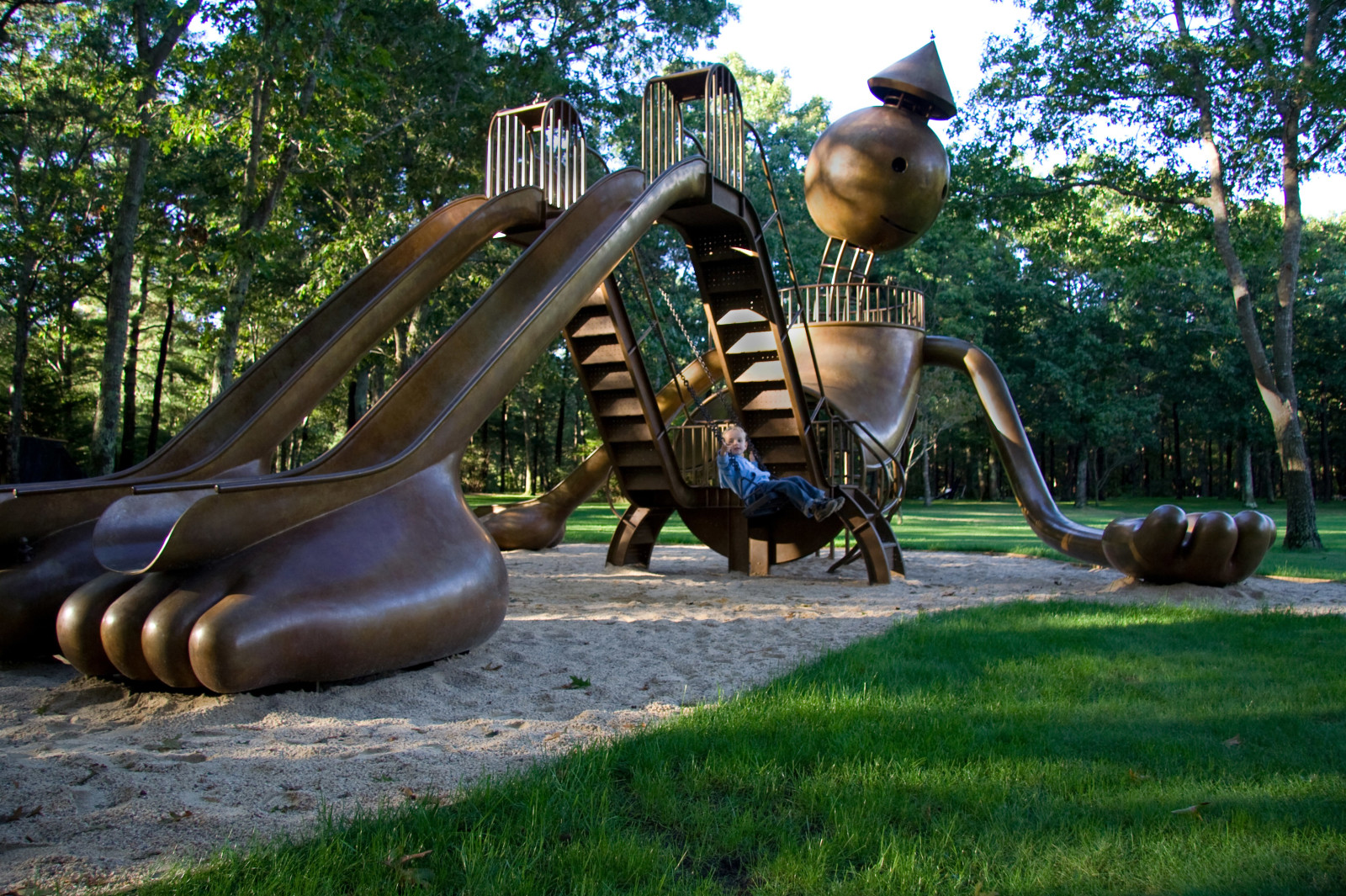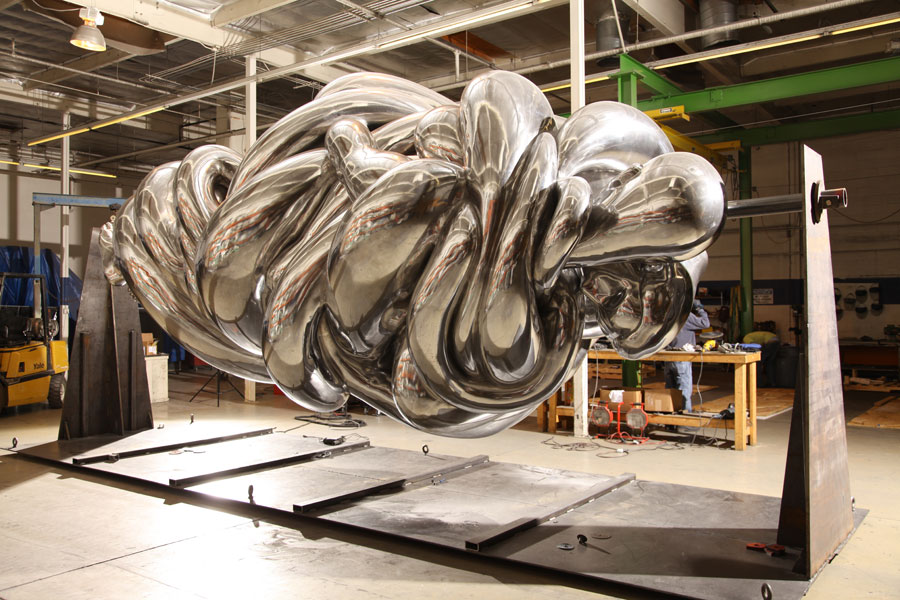
You would never guess by looking at it, but inside a warehouse tucked at the end of a cul-de-sac in a non-descript industrial park in Tempe, Arizona, a skilled group of artisans is busy casting and fabricating some of the world’s finest works of contemporary metal art and design.
The new space—10,000 square feet with 30′ ceilings—signifies not only forward thinking on the part of its occupants, fine arts foundry Bollinger Atelier, but a shift in scale within the world of sculpture. “We’re planning for bigger business, bigger sculpture,” says Kim Nikolaev, Director of Special Projects for the atelier. “We’re seeing more large-scale projects, which take longer to produce, but clients seem to want things faster. This additional space can accommodate equipment like a large bridge crane to help make that happen.”
Despite the trend to larger works of art, Bollinger Atelier is determined to maintain its boutique status, with no plans for increasing volume or its twenty-one staff roster significantly in the coming years. Indeed, it is this commitment to staying small and focused on the client that best defines the value of doing business with Bollinger.
Not a Foundry
Founder and Managing Owner Tom Bollinger eschews the term “foundry.” “A foundry is where you melt metal,” he explains. “We think of ourselves as less industrial and more artisanal, a fabricator of custom contemporary works for artists and designers all over the world.”
Being a player in the global art community was a major goal for the business when Bollinger purchased it (then Arizona Bronze Fine Arts Foundry) in 1997. A sculpture and business administration graduate of Dickinson State University in North Dakota, Bollinger had worked for Arizona Bronze right out of college before moving on to work at other foundries around the country. Purchasing the Tempe-based business was a homecoming for sure, but it came with Bollinger’s firm determination follow his personal vision.
“I had managed other facilities and thought I could do a better job, in a unique way,” Bollinger recalls. “I had to push in all my chips with the purchase of this business. And it was important to me that I could be the owner/operator and call all the shots. It’s still a very entrepreneurial-spirited business—we’re all very intent and very hard workers here. I don’t want 150 employees because, in my opinion, that’s too many people. The art gets lost.”
Keeping things personal with clients is a core business value. “This is a relationship business,” Bollinger explains. “We’re in a partnership with the artist to meet the goals of the project by offering technical expertise, translating the client’s vision into what is physically possible to create, within their budget and timeframe.”
Though Bollinger is the company’s undisputed leader, technical guru, and “holder of knowledge,” and even manages to create his own sculpture every once in awhile (though less than he would like), he naturally relies on the skills and talents of his employees to realize the vision of his clients. Many of the foundry’s twenty-one employees come from nearby Arizona State University, which boasts solid sculpture and foundry programs, and works closely with Bollinger Atelier in training the next generation on the science and magic of cast and fabricated metal. Bollinger employees are encouraged to create their own work in the foundry, and are given the time and resources to do it.
“It’s like a lab in here,” says Nikolaev. “We encourage hands-on experience to help make us better problem solvers for our clients.”
Going Big, Boutique Style
Thirty years ago, it was not uncommon for sculptures to be cast or enlarged using very time-consuming hand processes and paper-and-pencil calculations. Today, clients may come to Bollinger Atelier without even a 3D model in hand. Sketches or even ideas are common starting points. Technological advancements in rapid prototyping, 3D modeling and printing, and CNC milling can take a project from idea to three-dimensional model or sculpture without the client ever having touched a piece of paper or ball of clay. Evolutions in molding, casting, fabrication, and finishing have opened up worlds of possibility to artists and artisans alike, though not always practical.
“There’s a continual balancing act between the aesthetic of a piece and what’s physically possible,” notes Jacob Sterenberg, Bollinger’s General Manager & Digital Specialist. “A sculpture has to be able stand up and not crush the people walking past it. So in addition to aesthetics, we also have to think about things like strength and stability, and how to make a piece structurally viable in order to meet city codes.”
New technologies have helped to reduce the cost of production, particularly for large-scale artworks; Bollinger Atelier has fabricated larger-than-life sculpture for Tom Sachs, Donald Baechler, and Louise Bourgeois, to name a few. Just recently, the company completed a 100′ stainless steel sculpture by Roxy Paine, part of his Dendroid series, for the City of San Francisco, which will be installed once the building infrastructure is complete. A particularly unique, large-scale project in the works is for an international clock that will be built into the side of a mountain, and requires custom cast and fabricated components.

Smaller pieces likewise abound. A bronze sink cast from an architect’s own sculpture. A fireplace design for internationally acclaimed architect Will Bruder. Architectural elements for a LEED-certified building company. As lines between architect, designer, and artist continue to bend and blur, Bollinger Atelier helps “fill in the blanks” where the client needs it, ensuring every piece is a creative and practical success.
It’s all part of the challenge and fun for the team at Bollinger Atelier: working together to solve the problems inherent in any given project.
“Every project we take on becomes its own R&D experience,” says Nikolaev. “There’s nothing rote about what we do. Artists come to us because of Tom’s experience and reputation, then everyone here puts their all into understanding what it is the artist wants. It’s just a really unique partnership.”